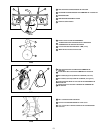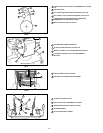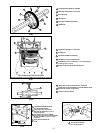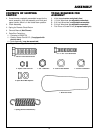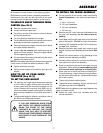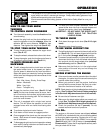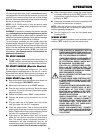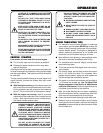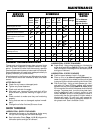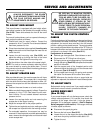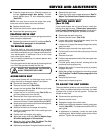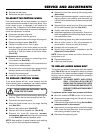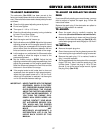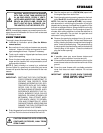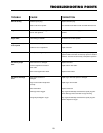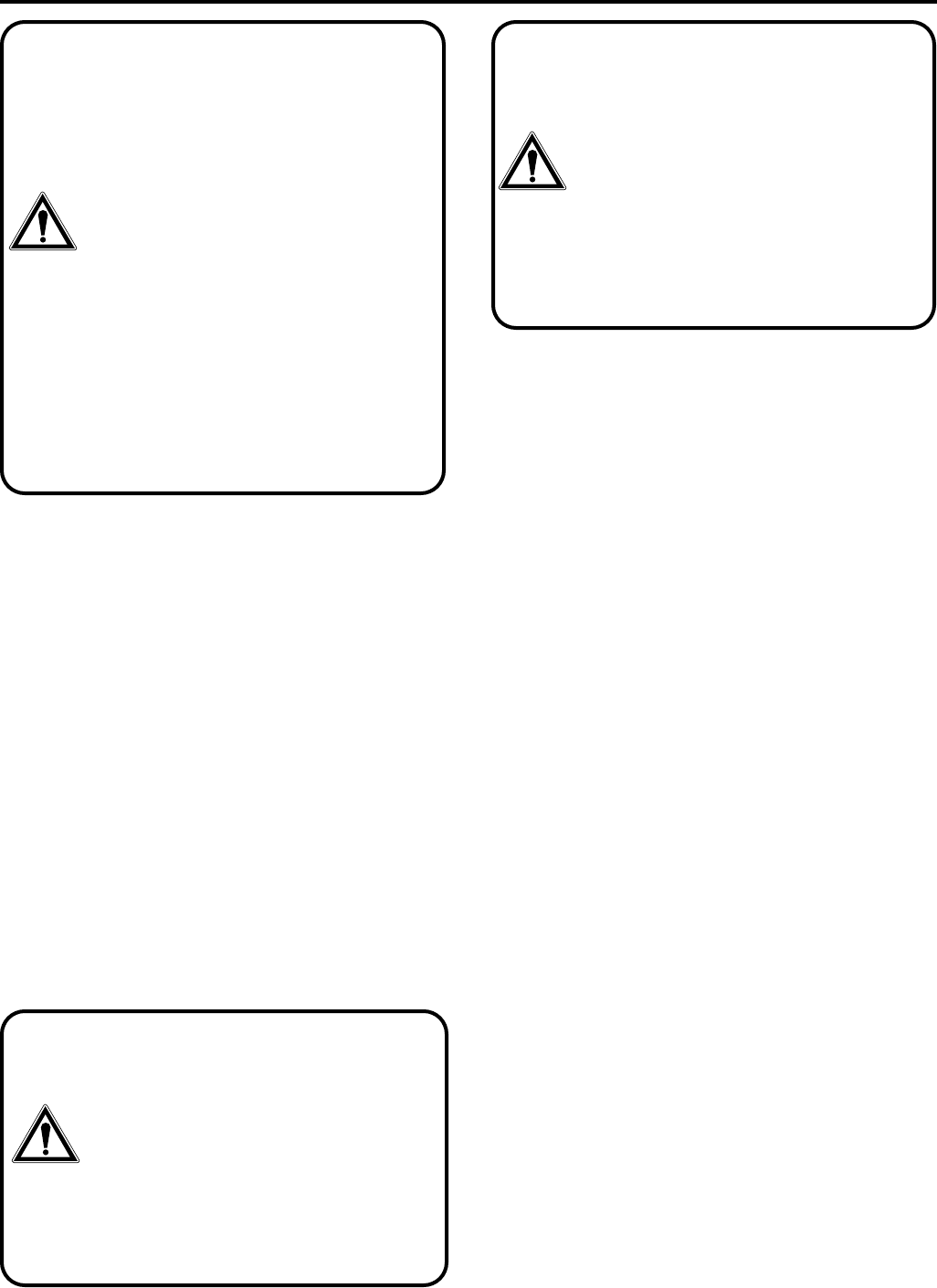
21
OPERATION
NEVER RUN ENGINE INDOORS OR IN EN-
CLOSED, POORLY VENTILATED AREAS.
ENGINE EXHAUST CONTAINS CARBON
MONOXIDE, AN ODORLESS AND DEADLY
GAS. KEEP HANDS, FEET, HAIR AND LOOSE
CLOTHING AWAY FROM ANY MOVING
PARTS ON ENGINE AND SNOW THROWER.
WARNING: TEMPERATURE OF MUFFLER
AND NEARBY AREAS MAY EXCEED 150
° F.
AVOID THESE AREAS.
DO NOT ALLOW CHILDREN OR YOUNG
TEENAGERS TO OPERATE OR BE NEAR
SNOW THROWER WHILE IT IS OPERATING.
FROZEN STARTER
If the starter is frozen and will not turn engine:
● Pull as much rope out of the starter as possible.
● Release the starter handle and let it snap back
against the starter.
If the engine still fails to start, push the primer button two
or three times again and repeat the two previous steps
until the engine starts. Then continue with the directions
for cold start.
To help prevent possible freeze-up of recoil starter and
engine controls, proceed as follows after each snow
removal job.
● With the engine running, pull the starter rope hard
with a continuous full arm stroke three or four times.
Pulling of starter rope will produce a loud clattering
sound. This is not harmful to the engine or starter.
● With the engine not running, wipe all snow and
moisture from the carburetor cover in area of control
levers. Also move throttle control, choke control,
and starter handle several times.
DO NOT ATTEMPT TO REMOVE ANY ITEM
THAT MAY BECOME LODGED IN AUGER
WITHOUT TAKING THE FOLLOWING PRE-
CAUTIONS:
● RELEASE AUGER DRIVE AND TRACTION
DRIVE LEVERS.
● MOVE THROTTLE LEVER TO STOP PO-
SITION.
● REMOVE (DO NOT TURN) IGNITION KEY.
● DISCONNECT SPARK PLUG WIRE.
● DO NOT PLACE YOUR HANDS IN THE
AUGER OR DISCHARGE CHUTE. USE A
PRY BAR.
SNOW THROWING TIPS
● For maximum snow thrower efficiency in removing
snow, adjust ground speed, NEVER the throttle. Go
slower in deep, freezing or wet snow. If the unit slips,
reduce forward speed. The engine is designed to
deliver maximum performance at full throttle and
should be run at this power setting at all times.
● Most efficient snow blowing is accomplished when
the snow is removed immediately after it falls.
● For complete snow removal, slightly overlap each
path previously taken.
● The snow should be discharged down wind when-
ever possible.
● For normal usage, set the skids so that the scraper
bar is 1/8" above the skids. For extremely hard-
packed snow surfaces, adjust the skids upward so
that the scraper bar touches the ground.
● On gravel or crushed rock surfaces, set the skids at
1-1/4" below the scraper bar (see To Adjust Skid
Height paragraph in the Service & Adjustments
section of this manual). Rocks and gravel must not
be picked up and thrown by the machine.
● After the snow blowing job has been completed,
allow the engine to idle for a few minutes, which will
melt snow and accumulated ice off the engine.
● Clean the snow thrower thoroughly after each use.
● Remove ice and snow accumulation and all debris
from the entire snow thrower, and flush with water (if
possible) to remove all salt or other chemicals. Wipe
snow thrower dry.
GASOLINE IS FLAMMABLE AND CAUTION
MUST BE USED WHEN HANDLING OR STOR-
ING IT.
DO NOT FILL FUEL TANK WHILE SNOW
THROWER IS RUNNING, WHEN IT IS HOT,
OR WHEN SNOW THROWER IS IN AN EN-
CLOSED AREA.
KEEP AWAY FROM OPEN FLAME OR AN
ELECTRICAL SPARK AND DO NOT SMOKE
WHILE FILLING THE FUEL TANK.
NEVER FILL THE TANK COMPLETELY. FILL
THE TANK TO WITHIN 1/4" - 1/2" FROM THE
TOP TO PROVIDE SPACE FOR EXPANSION
OF FUEL.
ALWAYS FILL FUEL TANK OUTDOORS AND
USE A FUNNEL OR SPOUT TO PREVENT
SPILLING.
MAKE SURE TO WIPE UP ANY SPILLED FUEL
BEFORE STARTING THE ENGINE.
STORE GASOLINE IN A CLEAN, APPROVED
CONTAINER AND KEEP THE CAP IN PLACE
ON THE CONTAINER.



